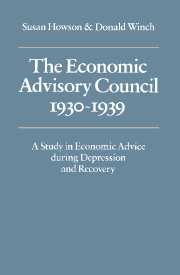3 - THE COUNCIL AND THE SLUMP
Published online by Cambridge University Press: 07 October 2011
Summary
The Council was in full operation when the world depression first began to make an obvious impression on the British economy. It held its first meeting on 17 February 1930 and met regularly at 10 Downing Street up to the thirteenth meeting on 16 April 1931. This chapter is concerned with the proceedings of the Council and its role in the policy-making machinery of the government up to the beginning of the 1931 financial crisis, which, as it turned out, settled the fate of the Council as well as that of the second Labour Government. During its comparatively brief life the Council set on foot and considered the results of many special inquiries, a list of which is in Appendix I; here we concentrate on those reports and discussions most relevant to the central issues of economic policy.
When the Labour Government took office, unemployment, though still above the million mark, was lower than it had been a year earlier. During the summer of 1929 and well into the autumn it was still possible to assume that the government was faced with problems which had to a large extent been peculiar to Britain throughout the post-war period. In retrospect, however, there were already signs of an international collapse of commodity prices due to overproduction in the primary-producing countries, and of increasing strain on the world's financial system.
- Type
- Chapter
- Information
- The Economic Advisory Council, 1930–1939A Study in Economic Advice during Depression and Recovery, pp. 30 - 81Publisher: Cambridge University PressPrint publication year: 1977



